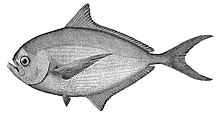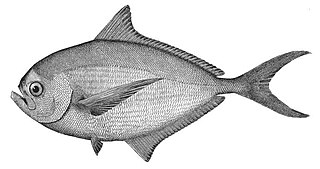
Pomfrets are perciform fishes belonging to the family Bramidae. The family currently includes 20 species across seven genera. Several species are important food sources for humans, especially Brama brama in South Asia. The earlier form of the pomfret's name was "pamflet", a word which probably ultimately comes from Portuguese pampo, referring to various fish such as the blue butterfish. The fish meat is white in color.

The Atlantic blue marlin is a species of marlin endemic to the Atlantic Ocean. It is closely related to, and usually considered conspecific with, the Indo-Pacific blue marlin, then simply called blue marlin. Some authorities still consider both species distinct.

The Atlantic pomfret, also known as Ray's bream, is a species of marine ray-finned fish, a pomfret of the family Bramidae. It is found in the Atlantic, Indian, and South Pacific Oceans, at depths down to 1,000 m (3,300 ft).
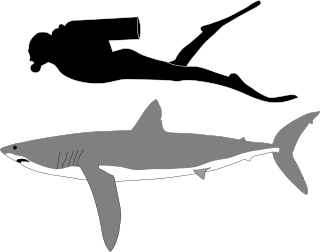
The longfin mako shark is a species of mackerel shark in the family Lamnidae, with a probable worldwide distribution in temperate and tropical waters. An uncommon species, it is typically lumped together under the name "mako" with its better-known relative, the shortfin mako shark. The longfin mako is a pelagic species found in moderately deep water, having been reported to a depth of 220 m (720 ft). Growing to a maximum length of 4.3 m (14 ft), the slimmer build and long, broad pectoral fins of this shark suggest that it is a slower and less active swimmer than the shortfin mako.
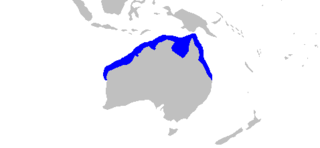
The creek whaler is a common species of requiem shark, and part of the family Carcharhinidae, endemic to northern Australia. It frequents shallow waters close to shore, including estuaries. This small, stocky shark usually grows to 1.0–1.3 m (3.3–4.3 ft) long and is brownish in color without conspicuous fin markings. It can be identified by its long snout, large, triangular pectoral fins, and large, anteriorly positioned first dorsal fin.

The cleftbelly trevally, also known as the cleftbelly kingfish, Kuweh trevally or thin crevalle, is a species of tropical marine fish of the jack family, Carangidae. The species inhabits coastal waters throughout the Indo-West Pacific region from South Africa in the west to Japan in the east, often found near the water's surface. The cleftbelly trevally is the only member of the genus Atropus and is distinguished by a number of anatomical characteristics, with a deep median groove in the belly giving the species its common name. It is not a large fish, growing to a maximum recorded length of 26.5 cm. Cleftbelly trevally are predatory fish, taking a variety of small crustaceans and fish. The species is of minor importance to fisheries throughout its range.

The longfin trevally, also known as the longfin kingfish, longfin cavalla or armed trevally, is a species of inshore marine fish in the jack family, Carangidae. The species is common in tropical to subtropical waters of the Indo-Pacific, ranging from South Africa in the west to Japan in the east, typically inhabiting inshore reefs and bays. The species is easily distinguished by its elongate dorsal and anal fin lobes and filamentous dorsal rays, as well as its scaleless breast. Longfin trevally are pelagic predators, taking a variety of small fish, cephalopods and crustaceans, and reach sexual maturity at around 21 cm. The species has a maximum known length of 57 cm and weight of 3.5 kg. The longfin trevally has a very complex taxonomic history which is closely intertwined with another currently valid species, Carangoides ciliarius, which may yet prove to be synonymous. Longfin trevally are of minor importance to fisheries throughout their range and are considered good table fish, and are occasionally taken by anglers.
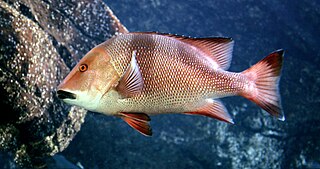
Lutjanus sebae, also known as red emperor, emperor red snapper, emperor snapper, government bream, king snapper, queenfish or red kelp, is a species of marine ray-finned fish, a snapper belonging to the family Lutjanidae. It is native to the Indian Ocean and the western Pacific Ocean.

The dark-banded fusilier, also known as blue-streak fusilier, bluedash fusilier, or neon fusilier, is a species of marine ray-finned fish, a fusilier belonging to the family Caesionidae. It has a wide Indo-West Pacific range. It is of some importance to fisheries within its range.

Pterycombus is a genus of pomfret distinguished by greatly elongated dorsal and anal fins. Along with the genus Pteraclis, these fishes are commonly referred to as fanfishes. Pterycombus can be distinguished from Pteraclis by examining the dorsal and anal fin rays, which should be relatively uniform in thickness to neighboring rays and by a lack of scales anterior to the dorsal fin.
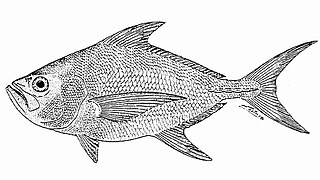
Taractes is a genus of marine ray-finned fishes from the family Bramidae, the pomfrets. Taractes can be distinguished from other bramid genera but having a flat, or slightly curved profile, between the eyes and by having scales on both the dorsal and anal fins.

Taractichthys steindachneri, the sickle pomfret, is a species of marine ray-finned fish, a pomfret of the family Bramidae. It is found in the Indian and Pacific Oceans.

The lunar fusilier, also known as the blue fusilier or moon fusilier, is a species of marine ray-finned fish, a fusilier belonging to the family Caesionidae. It is widespread throughout the tropical waters of the Indo-West Pacific area.

Minous monodactylus, the grey stingfish or grey goblinfish, is a species of marine ray-finned fishes, it is the only genus in the tribe Minoini, one of the three tribes which are classified within the subfamily Synanceiinae within the family Scorpaenidae, the scorpionfishes and their relatives. This species found in the Indo-Pacific and is venomous to humans.

Brama australis, the Southern Ray's bream or Pacific pomfret, is a species of marine ray-finned fish from the family Bramidae, the pomfrets. It is found in the southern Oceans.

Brama japonica, the Pacific pomfret, is a species of marine ray-finned fish, a pomfret of the family Bramidae. B. japonica is closely related, and quite similar, to Brama brama, but can be distinguished by possessing a greater number of anal fin rays and a higher number of gill rakers.

Taractes rubescens, the pomfret, keeltail pomfret, knifetail pomfret or black pomfret, is a species of marine ray-finned fish, a pomfret of the family Bramidae. T. rubescens is closely related, and quite similar, to Taractes asper, but adults can most easily be distinguished by the bony keel present on the caudal peduncle. In fact, this bony keel is unique to Taractes rubescens and will distinguish it from all other bramids.
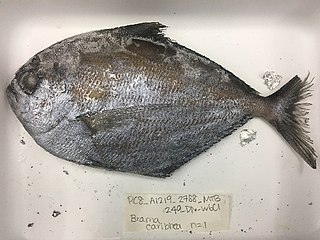
Brama caribbea, the Caribbean pomfret, is a species of marine ray-finned fish, a pomfret of the family Bramidae. It is found in the Western Atlantic Ocean.

Brama dussumieri, the lesser bream or lowfin pomfret, is a species of marine ray-finned fish, a pomfret of the family Bramidae. It is found in warm seas around the world.

Pentanogmius is an extinct genus of sail-finned ray-finned fish that lived during the Late Cretaceous in what is now Europe and the USA. Five species are currently recognized, 2 from Cenomanian to Turonian Europe and 3 better known species from Coniacian to Campanian North America. The American species inhabited large areas of the Western Interior Seaway, with fossil finds indicating a range from Texas and Alabama in the south to Manitoba, Canada, in the north.
